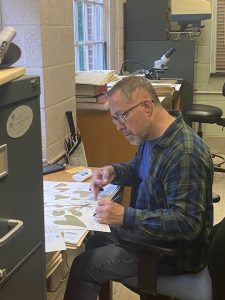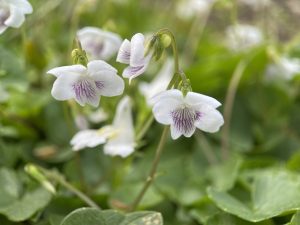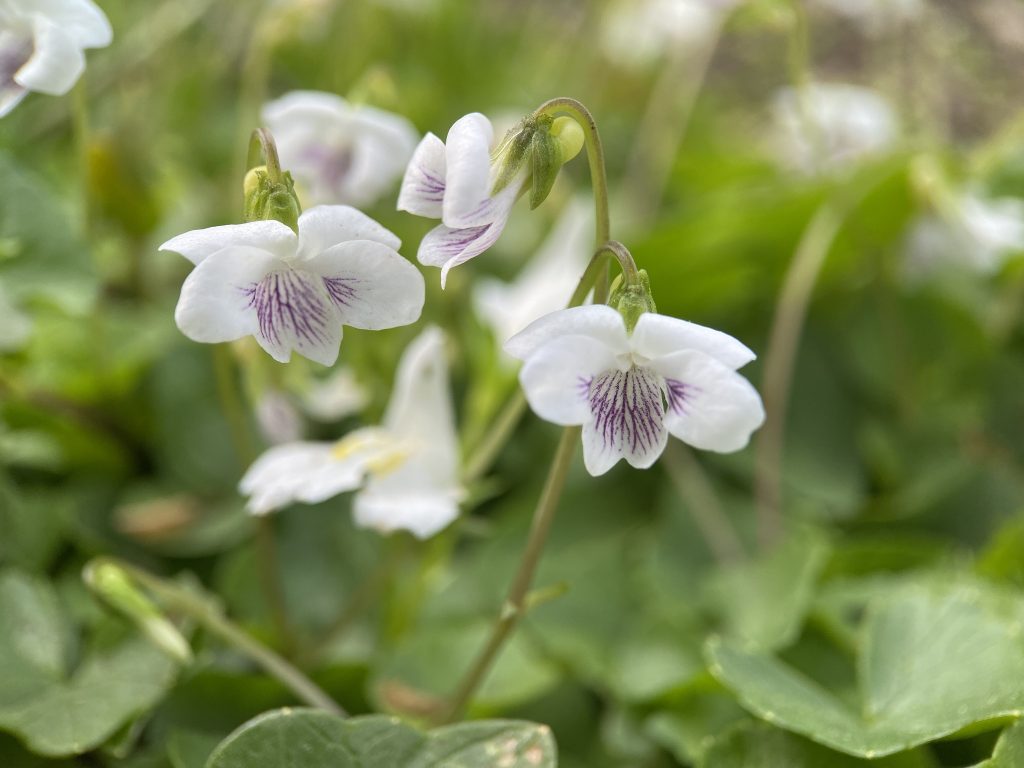
by Carol Ann McCormick, Curatrix of the University of North Carolina Herbarium (NCU)
ORCID: 0000-0003-3785-8433
In July 2024 the University of North Carolina at Chapel Hill Herbarium (NCU) hosted Dr. Harvey Ballard for a week. Dr. Ballard, Curator of the Floyd Bartley Herbarium (BHO) at Ohio University in Athens, is an expert on the Violet Family, and during his week-long visit, he examined all our specimens of violets (Viola) and green-violets (Cubelium; previously known as Hybanthus) from North Carolina and Virginia.
On a blessedly rainy Friday afternoon, Dr. Ballard brought one herbarium sheet to my desk, and said, “You’ve got an interesting violet here.” I took a glance at the specimen label and noted that the plant had been collected in Anson County, North Carolina by Becky Dill. Dr. Ballard told me, “I was visiting the New York Botanical Garden a couple of years ago, and in one of the lawns I saw a violet that I did not immediately recognize. I got down on my hands and knees to take a closer look, and confirmed that I was seeing something unusual. Turns out it was an Asian species, Viola arcuata, and the lawn at the New York Botanical Garden was the first documented occurrence of the plant in North America. It has since been documented in New Jersey… and just now, in Anson County, North Carolina!”
Ms. Dill’s specimen was labeled as Viola striata, but her iNaturalist post of the plant in 2022 reflected uncertainty. “I am not sure of this ID. This is a volunteer colony in a consistently wet area of my wooded backyard. Flowers are very white, not cream in color. Not a single bloom was wide open, all were constricted as in the photos. Stipule visible in 3rd pic [picture]. One big hesitation is that the leaf tip is rounded, whereas RAB5 describes striata leaves as acute to acuminate. I will dig up a plant today and look at roots.”1 A year later, her doubts continued, “I tried to key this and it didn’t work for me , although the small white, caulescent blooms and broad leaves should have been easy, right? I could not fit the stipules in with other plant characteristics. The closest one was Viola striata, but the leaves don’t seem to fit either.”2 Ms. Dill is one of our premier community scientists so she dug up a few plants, pressed them, and sent them to the Herbarium in Chapel Hill. In May, 2023 Ms. Dill’s violet was accessioned as NCU 679134, and filed under Viola striata, North Carolina, Anson County.

Dr. Ballard pointed to Ms. Dill’s label on NCU 679134 and said to me, “Look at her notes on habitat where she found this growing — “Year-round seepage area at edge of mixed woods, disturbed soil” — this fits perfectly with the places I’ve found it.” In a 2023 paper, Ballard wrote about Viola arcuata, “In its native range [east temperate and tropical Asia] this species is said to inhabit “Moist and marshy places, grasslands, grassy places on mountain slopes, thickets, forest margins, fields, alongside houses” (Chen et al. 2007); in and around The New York Botanical Garden the violet is common in moister well-watered areas of lawns; in a park farther south in New York City and another park along Skyline Drive in New Jersey the violet grows in planting beds or pots, presumably brought in with nursery stock or bedding plants.”3
Ms. Dill’s reluctant identification of her violet at Viola striata was reasonable. “[Viola arcuata ] is distinctive in its broadly reniform-deltate cauline leaves with somewhat remotely low-serrate margins, but the occasionally white corolla, short spur, and basally reclining stems could be confused with V. striata if the proportionally broader leaf blades were ignored. The commonly node-rooting basal portion of the stems and slender entire to remotely denticulate stipules would distinguish this species,” notes Ballard in his 2023 manuscript.3
At the North Carolina Botanical Garden one tenet of our visitor safety policy is “if you see something, say something, then do something”. I’m thinking of extending and slightly modifying that policy for botanists to be “if you see something, make an iNaturalist observation, then collect something”.

Now that this non-native violet has been documented in Anson County, perhaps other keen-eyed naturalists will document it elsewhere in the southeast by submitting specimens to their friendly local herbarium. For instructions on how to collect a plant for an herbarium, see Pressing Matters.
Congrats to Ms. Dill on her State (if not regional!) Record, and many thanks to Dr. Harvey Ballard for his work on NCU’s violet collection.
SOURCES:
- Becky Dill. 2022. https://www.inaturalist.org/observations/108168286 . Accessed on 12 July 2024.
- Becky Dill. 2023. https://www.inaturalist.org/observations/150164116 . Accessed on 12 July 2024.
- Ballard, Harvey E., Jr., John T. Kartesz, and Misako Nishino. 2023. A taxonomic treatment of the violets (Violaceae) of northeastern United States and adjacent Canada.The Journal of the Torrey Botanical Society 150 (1), 3-266.
- Zihou Wang 2022. https://www.inaturalist.org/observations/164725533 . Accessed on 13 July 2024.
- Radford, Ahles and Bell. 1968. Manual of the Vascular Flora of the Carolinas. The University of North Carolina Press.
- Chen, Y. S., Y. Quin-Er, H. Ohba, and V. V. Nikitin. 2007. Violaceae, pp. 74–111. In Y. S. Chen, Y. Quin-Er, H. Ohba, and V. V. Nikitin, eds. Flora of China, vol. 13. Science Press, Beijing, China, and Missouri Botanical Garden Press, St. Louis, MO.
